Sony CCD-TRV118, CCD-TRV150, CCD-TRV318, CCD-TRV418, DCR-TRV250 Operating Instruction
...
3-079-467-13 (1)
Digital
Video Camera Recorder 

Video Camera Recorder
Operating Instructions
Before operating the unit, please read this manual thoroughly, and retain it for future reference.
Owner’s Record
The model and serial numbers are located on the bottom. Record the serial number in the space provided below. Refer to these numbers whenever you call upon your Sony dealer regarding this product.
Model No. |
|
-TRV |
|
Model No. AC- |
|
|
|
|
|
||||
Serial No. |
|
|
|
Serial No. |
|
|
|
|
|
|
|
||
DCR-TRV350 |
TM
SERIES
DCR-TRV150/TRV250/TRV350/TRV351 
CCD-TRV118/TRV318/TRV418
©2003 Sony Corporation
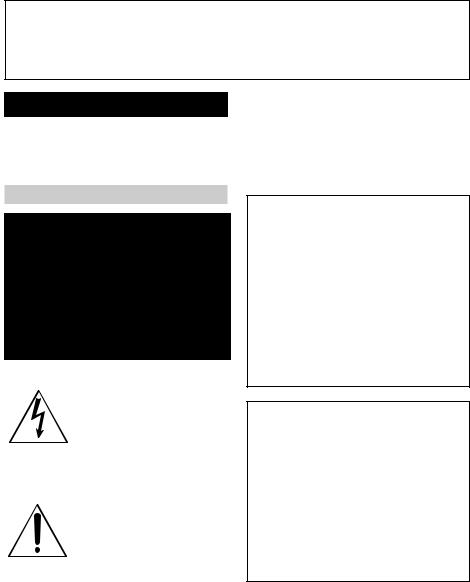
Welcome!
Congratulations on your purchase of this Sony Handycam. With your Handycam, you can capture life’s precious moments with superior picture and sound quality. Your Handycam is loaded with advanced features, but at the same time it is very easy to use. You will soon be producing home video that you can enjoy for years to come.
WARNING
To prevent fire or shock hazard, do not expose the unit to rain or moisture.
If you have any questions about this product, you may call:
Sony Customer Information Center 1-800-222- SONY (7669)
The number below is for the FCC related matters only.
Regulatory Information
For the customers in the U.S.A.
This symbol is intended to alert the user to the presence of uninsulated “dangerous voltage” within the product’s enclosure that may be of sufficient magnitude to constitute a risk of electric shock to persons.
This symbol is intended to alert the user to the presence of important operating and maintenance (servicing) instructions in the literature accompanying the appliance.
Declaration of Conformity
Trade Name: |
SONY |
Model No.: |
DCR-TRV150, |
|
DCR-TRV250 |
Responsible Party: |
Sony Electronics Inc. |
Address: |
680 Kinderkamack |
|
Road, Oradell, |
|
NJ07649 U.S.A. |
Telephone No.: |
201-930-6972 |
This device complies with Part 15 of the FCC Rules. Operation is subject to the following two conditions: (1) This device may not cause harmful interference, and (2) this device must accept any interference received, including interference that may cause undesired operation.
Declaration of Conformity
Trade Name: |
SONY |
Model No.: |
DCR-TRV350 |
Responsible Party: |
Sony Electronics Inc. |
Address: |
680 Kinderkamack |
|
Road, Oradell, |
|
NJ07649 U.S.A. |
Telephone No.: |
201-930-6972 |
This device complies with Part 15 of the FCC Rules. Operation is subject to the following two conditions: (1) This device may not cause harmful interference, and (2) this device must accept any interference received, including interference that may cause undesired operation.
CAUTION
You are cautioned that any changes or modifications not expressly approved in this manual could void your authority to operate this equipment.
2

Note:
This equipment has been tested and found to comply with the limits for a Class B digital device, pursuant to Part 15 of the FCC Rules. These limits are designed to provide reasonable protection against harmful interference in a residential installation. This equipment generates, uses, and can radiate radio frequency energy and, if not installed and used in accordance with the instructions, may cause harmful interference to radio communications. However, there is no guarantee that interference will not occur in a particular installation. If this equipment does cause harmful interference to radio or television reception, which can be determined by turning the equipment off and on, the user is encouraged to try to correct the interference by one or more of the following measures:
—Reorient or relocate the receiving antenna.
—Increase the separation between the equipment and receiver.
—Connect the equipment into an outlet on a circuit different from that to which the receiver is connected.
—Consult the dealer or an experienced radio/TV technician for help.
The supplied interface cable must be used with the equipment in order to comply with the limits for a digital device pursuant to Subpart B of Part 15 of FCC Rules.
For the customers in the
U.S.A. and CANADA
CAUTION
TO PREVENT ELECTRIC SHOCK, MATCH WIDE BLADE OF PLUG TO WIDE SLOT, FULLY INSERT.
RECYCLING LITHIUM-ION
Lithium-Ion batteries are recyclable.
You can help preserve environment by returning your used rechargeable batteries to the collection recycling location nearest you.
For more information
rechargeable batteries, call toll free 1-800-822- 8837, or visit http://www.rbrc.org/.
Caution: Do not handle damaged or leaking Lithium-Ion batteries.
3
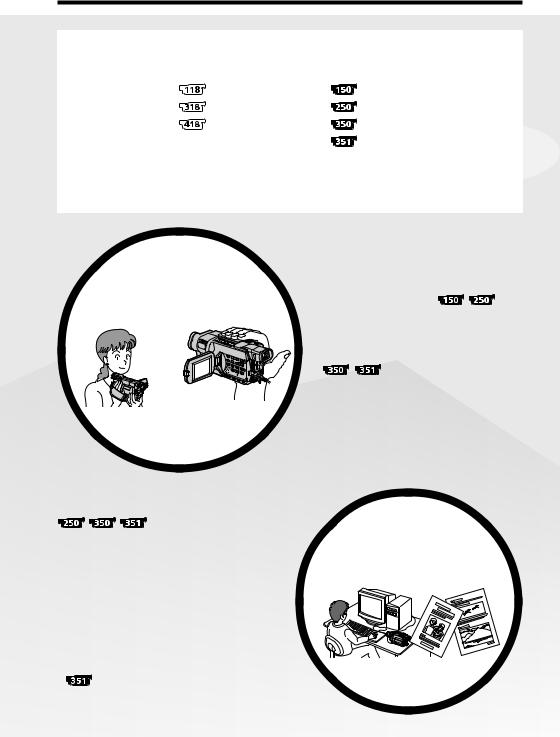
Main Features
On the model name indication
In this manual, camcorder-shape icons are used to indicate model names.
CCD-TRV118 : |
DCR-TRV150 : |
CCD-TRV318 : |
DCR-TRV250 : |
CCD-TRV418 : |
DCR-TRV350 : |
|
DCR-TRV351 : |
Instructions with no icons are for all models. Instructions with icons are for the indicated models only.
Before you start reading this manual, check the model name of your camcorder.
Features Main
Recording moving or still |
On the tape |
|
•Recording moving pictures (p. 30) |
||
images, and playing them |
•Recording still images |
|
back |
(p. 56) |
|
b |
•Playing back a tape (p. 45) |
|
On the “Memory Stick” |
||
|
||
|
•Recording still images (p. 132) |
|
|
•Recording moving pictures (p. 146) |
|
|
•Viewing still images (p. 163) |
|
|
•Viewing moving pictures (p. 166) |
•Viewing pictures recorded on a tape or live from your camcorder on your computer
– USB Streaming (p. 183)
•Capturing images on your computer from your camcorder using the USB cable (p. 197)
•Viewing images recorded on a “Memory Stick” using the USB cable 
 (p. 185)
(p. 185)
•Converting an analog signal into digital to capture images onto your computer 
(p. 208)
Capturing images on your computer
4
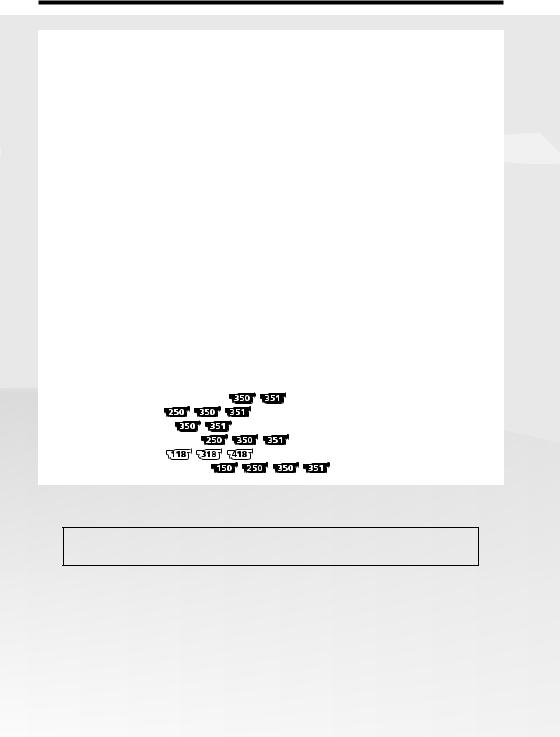
Main Features
Other uses
Functions for adjusting exposure in the recording mode
•BACK LIGHT (p. 38) •NightShot (p. 39)
•Super NightShot/Color Slow Shutter 
 (p. 39, 40) •PROGRAM AE (p. 68)
(p. 39, 40) •PROGRAM AE (p. 68)
•Adjusting the exposure manually (p. 70) •Built-in light (p. 79)
Functions for giving images more impact
•Digital zoom (p. 34) The default setting is OFF. (To zoom greater than 20× , select the digital zoom power in D ZOOM in the menu settings.)
•Fader (p. 61)
•Picture effect (In recording mode) (p. 64)
•Digital effect (In recording mode) 
 (p. 65) •Title (p. 75, 77)
(p. 65) •Title (p. 75, 77)
•MEMORY MIX 
 (p. 140)
(p. 140)
Functions for giving a natural appearance to your recordings
•SPORTS (p. 68) •LANDSCAPE (p. 68) •Manual focus (p. 71)
Functions for use on recorded tapes
•END SEARCH (p. 43)
•EDITSEARCH/Rec Review |
(p. 43) |
•DATA CODE |
(p. 47) |
•Tape PB ZOOM |
(p. 87) |
•ZERO SET MEMORY |
(p. 89) |
•Easy Dubbing |
(p. 98) |
•Digital program editing |
(p. 106) |
Contents of the recording cannot be compensated if recording or playback is not made due to a malfunction of the camcorder, storage media, etc.
Started Getting
Features Main
5
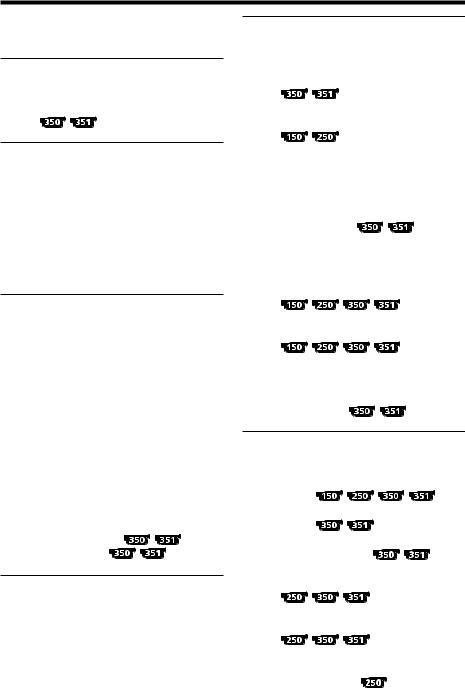
Table of contents
Main Features .......................................... |
4 |
Checking supplied accessories .............. |
9 |
Quick Start Guide |
|
– Recording on a tape ........................... |
10 |
– Recording on a “Memory Stick” |
|
...................................... |
12 |
Getting Started |
|
Using this manual ................................. |
14 |
Step 1 Preparing the power supply ... |
18 |
Installing the battery pack............. |
18 |
Charging the battery pack ............. |
19 |
Connecting to a wall outlet ........... |
24 |
Step 2 Setting the date and time ........ |
26 |
Step 3 Inserting a cassette ................... |
28 |
Recording – Basics |
|
Recording a picture ............................... |
30 |
Shooting a backlit subject |
|
– BACK LIGHT ........................ |
38 |
Shooting in the dark
–NightShot
–Super NightShot 

–Color Slow Shutter

 ............................ 39 Self-timer recording
............................ 39 Self-timer recording

 ............................... 41
............................... 41
Superimposing the date and time on pictures


 .................... 42 Checking recordings
.................... 42 Checking recordings
–END SEARCH
–EDITSEARCH
– Rec Review ............. |
43 |
Playback – Basics |
|
Playing back a tape ............................... |
45 |
To display the screen indicators |
|
– Display function ................... |
47 |
Viewing recordings on TV ................... |
51 |
Advanced Recording |
|
Operations |
|
Recording still images on a “Memory |
|
Stick” while recording on a tape |
|
...................................... |
53 |
Recording still images on a tape |
|
– Tape Photo recording |
|
...................................... |
56 |
Using the wide mode ........................... |
58 |
Using the fader function ...................... |
61 |
Using special effects |
|
– Picture effect ................................. |
64 |
Using special effects |
|
– Digital effect ........... |
65 |
Using the PROGRAM AE function |
.... 68 |
Adjusting the exposure manually ...... |
70 |
Focusing manually ................................ |
71 |
Interval recording |
|
................ |
72 |
Frame by frame recording |
|
– Frame recording |
|
................ |
74 |
Superimposing a title ........................... |
75 |
Making your own titles ........................ |
77 |
Using the built-in light ......................... |
79 |
Inserting a scene .............. |
82 |
Advanced Playback |
|
Operations |
|
Playing back a tape with picture |
|
effects |
.... 83 |
Playing back a tape with digital |
|
effects .......................... |
85 |
Enlarging recorded images |
|
– Tape PB ZOOM ...... |
87 |
Quickly locating a scene |
|
– ZERO SET MEMORY |
|
........................... |
89 |
Searching for a recording by date |
|
– DATE SEARCH |
|
........................... |
90 |
Searching for a photo |
|
– PHOTO SEARCH/ |
|
PHOTO SCAN ..................... |
92 |
6
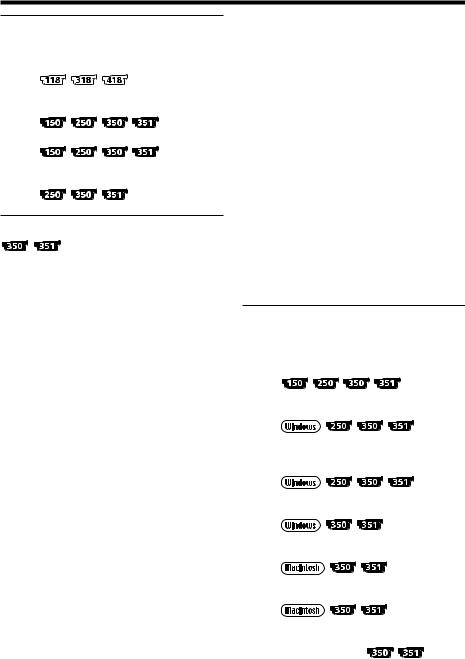
Table of contents
Editing |
|
Dubbing a tape ...................................... |
94 |
Dubbing a tape easily – Easy Dubbing |
|
........................... |
98 |
Dubbing only desired scenes |
|
– Digital program editing (on tapes) |
|
.............. |
106 |
Recording video or TV programs |
|
.............. |
119 |
Inserting a scene from a VCR |
|
– Insert Editing |
|
......................... |
123 |
“Memory Stick” Operations |
|
– Recording |
|
Using a “Memory Stick” |
|
– Introduction ............................... |
126 |
Recording still images on a “Memory |
|
Stick” |
|
– Memory Photo recording ......... |
132 |
Recording images from a tape as still |
|
images ............................................ |
136 |
Superimposing a still image in the |
|
“Memory Stick” on an image |
|
– MEMORY MIX .......................... |
140 |
Recording moving pictures on a |
|
“Memory Stick” |
|
– MPEG movie recording ............ |
146 |
Recording pictures from a tape as a |
|
moving picture ............................. |
150 |
Interval Photo recording .................... |
154 |
Recording edited pictures as a moving |
|
picture – Digital program editing |
|
(on a “Memory Stick”) ................. |
156 |
Setting up a folder ............................... |
160 |
– Playback |
|
Viewing still images |
|
– Memory Photo playback .......... |
163 |
Viewing moving pictures |
|
– MPEG movie playback ............. |
166 |
Selecting a folder to view ................... |
169 |
Copying images recorded on a |
|
“Memory Stick” to a tape ............ |
170 |
Enlarging still images recorded on a |
|
“Memory Stick” |
|
– Memory PB ZOOM ................... |
172 |
Playing back images continuously |
|
– SLIDE SHOW ............................. |
174 |
Preventing accidental erasure |
|
– Image protection ........................ |
176 |
Deleting images – DELETE ............... |
177 |
Writing a print mark |
|
– PRINT MARK ............................ |
180 |
Viewing Images on Your |
|
Computer |
|
Viewing images on your computer |
|
– Introduction |
|
.............. |
182 |
Connecting your camcorder to your |
|
computer using the USB cable |
|
......... |
187 |
Viewing pictures recorded on a tape |
|
or live from your camcorder on |
|
your computer – USB Streaming |
|
......... |
197 |
Viewing images recorded on a |
|
“Memory Stick” on your computer |
|
.................... |
202 |
Connecting your camcorder to your |
|
computer using the USB cable |
|
................... |
205 |
Viewing images recorded on a |
|
“Memory Stick” on your computer |
|
................... |
207 |
Capturing images from an analog video |
|
unit on your computer – Signal |
|
convert function ...... |
208 |
7
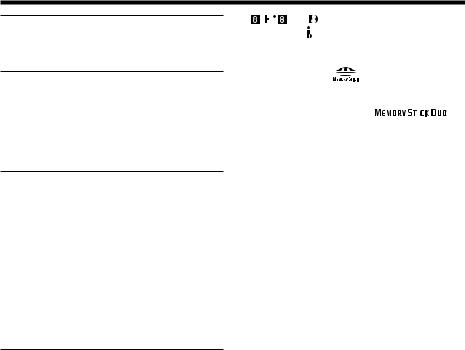
Table of contents
Customizing Your Camcorder
Changing the menu settings .............. |
210 |
Troubleshooting |
|
Types of trouble and how to correct |
|
trouble ............................................ |
224 |
Self-diagnosis display ......................... |
232 |
Warning indicators and messages .... |
233 |
Additional Information |
|
About video cassette ........................... |
237 |
About the “Memory Stick” ................ |
240 |
About the “InfoLITHIUM” battery |
|
pack ................................................ |
242 |
About i.LINK ....................................... |
244 |
Using your camcorder abroad .......... |
246 |
Maintenance information and |
|
precautions .................................... |
247 |
Specifications ....................................... |
253 |
Quick Reference |
|
Identifying parts and controls ........... |
256 |
Index ..................................................... |
267 |
• , |
and |
are trademarks. |
|
• i.LINK and |
are trademarks. |
||
•“InfoLITHIUM” is a trademark of Sony Corporation.
•“Memory Stick,” and “MagicGate Memory Stick” are trademarks of Sony Corporation.
and “MagicGate Memory Stick” are trademarks of Sony Corporation.
• “Memory Stick Duo” and  are trademarks of Sony Corporation.
are trademarks of Sony Corporation.
•Windows and Windows Media are trademarks or registered trademarks of Microsoft Corporation in the United States and/or other countries.
•Pentium is trademark or registered trademark of Intel Corporation.
•Macintosh and Mac OS, QuickTime are trademarks of Apple Computer Inc.
•All other product names mentioned herein may be the trademarks or registered trademarks of their respective companies. Furthermore, “™” and “®” are not mentioned in each case in this manual.
8
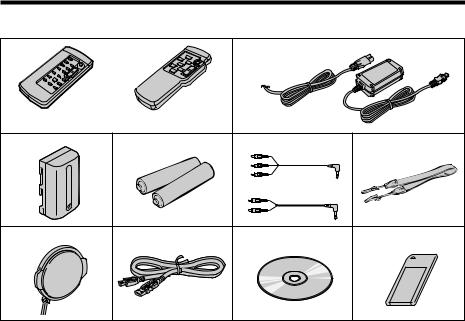
Checking supplied accessories
Make sure that the following accessories are supplied with your camcorder.
1 |
|
2 |
|
|
or |
|
|
RMT-814 |
|
RMT-708 |
|
3 |
4 |
5 |
6 |
|
|
|
Stereo |
|
|
|
or |
|
|
|
Monaural |
7 |
8 |
9 |
q; |
1Wireless Remote Commander (1) (p. 264)
RMT-814: 

 RMT-708:
RMT-708: 
2AC-L15A/L15B AC Adaptor (1), Power cord (1) (p. 19)
3NP-FM30 Rechargeable Battery Pack
(1) (p. 18, 19)
4Size AA (R6) battery for Remote
Commander (2) 


 (p. 264)
(p. 264)
5A/V connecting cable (1) (p. 51, 94, 95) Stereo: 



Monaural: 


6 Shoulder strap (1) (p. 256)
7 Lens cap (1) (p. 30)
8 USB cable (1) 

 (p. 182)
(p. 182)
9CD-ROM (SPVD-010 USB Driver) (1) 

 (p. 189)
(p. 189)
0 “Memory Stick” (1)  (p. 240)
(p. 240)
9
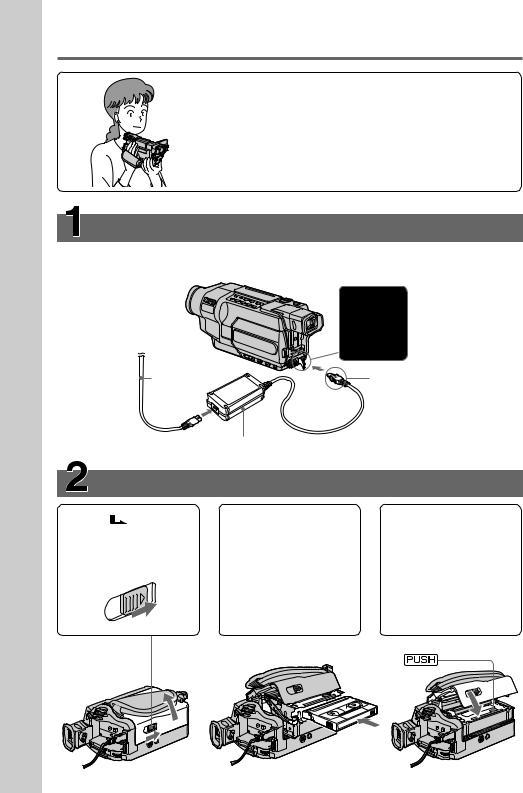
Guide Start Quick
Quick Start Guide – Recording on a tape
This chapter introduces you to the basic features to record on a tape of your camcorder. See the page in parentheses “( )” for more information.
Connecting the power cord (p. 24)
Use the battery pack when using your camcorder outdoors (p. 18).
Open the DC IN jack cover.
Power cord |
Connect the plug with |
|
its vmark facing up. |
AC Adaptor (supplied)
Inserting a cassette (p. 28)
1Slide OPEN/ EJECT in the direction of the arrow and open the lid.
2Push the center of the cassette back and insert the cassette properly with the cassette window facing up.
3Close the cassette compartment by
pressing  on the cassette compartment. After the cassette compartment goes down completely, close the lid.
on the cassette compartment. After the cassette compartment goes down completely, close the lid.
10
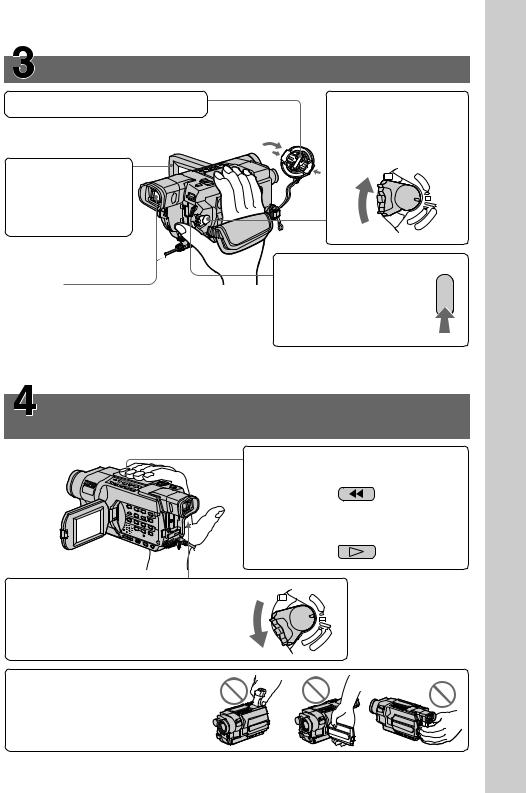
Recording a picture (p. 30)
1Remove the lens cap.
The cap is not attached when you purchase your camcorder.
3Open the LCD panel while pressing OPEN. The picture appears on the LCD screen.
2Set the POWER switch to CAMERA while pressing the small green button.
|
|
|
V |
|
O |
|||
|
|
|
|
C |
|
F |
||
|
|
|
|
R |
F |
|||
|
|
|
|
|
|
|
|
( |
PO |
|
|
|
|
|
|
|
C |
WER |
|
|
|
|
|
|
H |
|
|
|
|
|
|
|
|
G |
|
|
|
|
|
|
|
|
|
) |
|
|
|
|
E |
M |
|
A |
C |
|
R |
M |
|
M |
|
|||
|
Y |
O |
|
E |
|
|
||
|
|
|
|
R |
|
|
|
|
|
|
|
A |
|
|
|
|
|
|
4Press START/STOP. Your |
Viewfinder |
camcorder starts |
View a picture placing your eye against this part |
recording. To stop |
when the LCD panel is closed (p. 32). |
recording, press START/ |
Adjust the viewfinder lens to your eyesight (p. 35). |
STOP again. |
The picture in the viewfinder is black and white. |
|
When you purchase your camcorder, the clock is not set up yet. If you want to record the date and time for a picture, set the clock before recording (p. 26).
Monitoring the playback picture on the LCD screen (p. 45)
2Press mto rewind the tape.
REW 
3Press Nto start playback.
PLAY
1Set the POWER switch to VCR/PLAYER |
|
|
V |
|
O |
|||
while pressing the small green button.* |
|
|
|
C |
|
F |
||
|
|
|
R |
|
C |
|||
|
|
|
|
|
|
|
F |
|
|
|
|
|
|
|
|
|
( |
|
R |
|
|
|
|
|
|
H |
|
|
|
|
|
|
|
G |
|
WE |
|
|
|
|
|
|
||
PO |
|
|
|
|
|
|
|
) |
|
|
|
|
E |
M |
|
A |
C |
|
R |
M |
|
M |
|
|||
|
Y |
O |
|
E |
|
|
||
|
|
|
|
R |
|
|
|
|
|
|
|
A |
|
|
|
|
|
Guide Start Quick
Note
Do not pick up your camcorder by the viewfinder, the LCD panel, or the battery pack.
* Modes on the POWER switch vary depending on models (p. 16). |
11 |
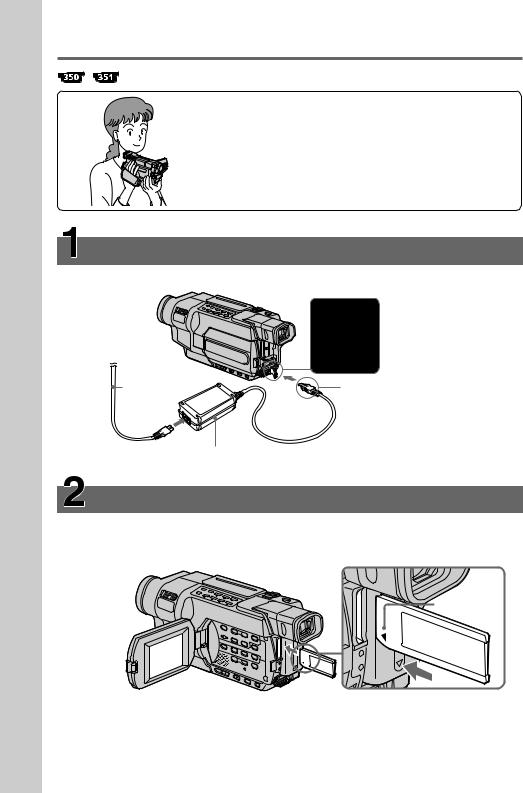
Guide Start Quick
Quick Start Guide – Recording on a “Memory Stick”
This chapter introduces you to the basic features to record on a “Memory Stick” of your camcorder. See the page in parentheses “( )” for more information.
Connecting the power cord (p. 24)
Use the battery pack when using your camcorder outdoors (p. 18).
Open the DC IN jack cover.
Power cord |
Connect the plug with its v |
|
mark facing up. |
AC Adaptor (supplied)
Inserting a “Memory Stick” (p. 127)
Insert a “Memory Stick” in the “Memory Stick” slot as far as it can go with the bmark facing the LCD panel as illustrated.
“Memory Stick” slot
b mark
When ejecting the “Memory Stick,” press the “Memory Stick” once lightly.
12
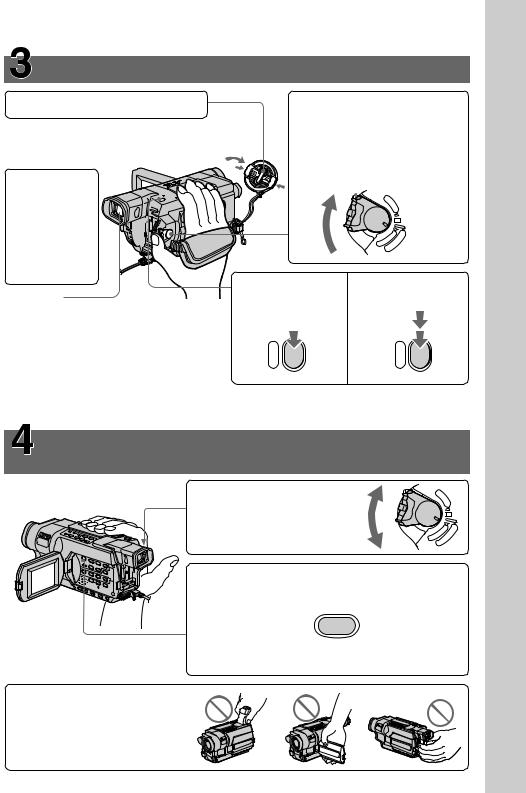
Recording a still image on a “Memory Stick” (p. 132)
1Remove the lens cap.
The cap is not attached when you purchase your camcorder.
3Open the 
 LCD panel
LCD panel 
 while
while 
 pressing
pressing 
OPEN. The picture appears on the screen.
Viewfinder
View a picture placing your eye against this part when the LCD panel is closed (p. 32). Adjust the viewfinder lens to your eyesight (p. 35).
The picture in the viewfinder is black and white.
2Set the POWER switch to MEMORY while pressing the small green button. Make sure that the LOCK switch is set to the left (unlock) position.
 LOCK switch
LOCK switch
|
|
V |
|
O |
|||
|
|
|
C |
|
F |
||
|
|
|
R |
F |
|||
|
|
|
|
|
|
|
( |
POWER |
|
|
|
|
|
|
C |
|
|
|
|
|
|
H |
|
|
|
|
|
|
|
G |
|
|
|
|
|
|
|
) |
|
|
|
|
E |
M |
|
A |
C |
|
|
|
|
|
|||
|
|
M |
|
M |
|
||
|
O |
|
|
|
|
||
R |
|
|
|
|
|
||
Y |
|
|
|
E |
|
|
|
|
|
|
R |
|
|
|
|
|
|
A |
|
|
|
|
|
4Press PHOTO |
5Press PHOTO |
lightly. |
deeper. |
PHOTO |
PHOTO |
When you purchase your camcorder, the clock is not set up yet. If you want to record the date and time for a picture, set the clock before recording (p. 26).
Monitoring the playback still images on the LCD
screen (p. 163)
1Set the POWER switch to |
|
R F |
||||
|
|
V |
|
O |
||
|
|
C |
|
|
|
|
MEMORY or VCR while |
|
|
|
|
F |
|
|
|
|
|
|
H |
|
|
|
|
|
|
|
( |
|
POWER |
|
|
|
|
C |
|
|
|
|
|
) |
|
pressing the small green |
|
|
|
|
|
G |
|
E |
M |
|
|
C |
|
button. |
|
|
A |
|||
YR |
M |
EM |
|
|||
|
O |
|
|
|
|
|
|
|
R |
|
|
|
|
|
|
A |
|
|
|
|
2Press MEMORY PLAY. The last recorded image is displayed.
PLAY
Press MEMORY +/– to select the desired image.
Note
Do not pick up your camcorder by the viewfinder, the LCD panel or the battery pack.
Guide Start Quick
13
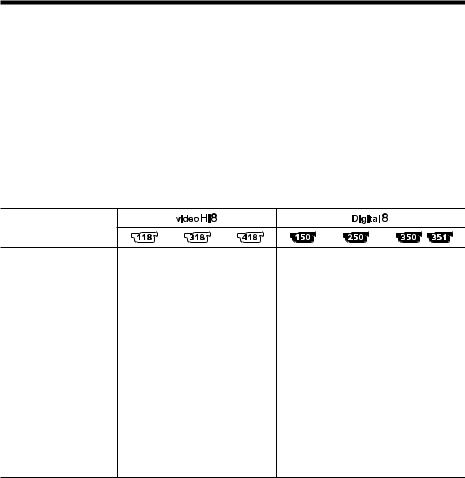
— Getting Started —
Using this manual
The instructions in this manual are for the seven models listed in the table below. Before you start reading this manual and operating your camcorder, check the model number by looking at the bottom of your camcorder. The DCR-TRV350 is the model used for illustration purposes. Otherwise, the model name is indicated in the illustrations. Any differences in operation are clearly indicated in the text, for example,
“ .”
.”
As you read through this manual, buttons and settings on your camcorder are shown in capital letters.
e.g. Set the POWER switch to CAMERA.
When you carry out an operation, you can hear a beep to indicate that the operation is being carried out.
Types of differences
Model
Recording system |
Hi8 |
Hi8 |
Hi8 |
Digital8 |
Digital8 |
Digital8 |
Playback system |
Hi8/8 |
Hi8/8 |
Hi8/8 |
Digital8 |
Digital8 |
Digital8/Hi8/8 |
|
|
|
|
|
|
|
AUDIO/VIDEO jack |
OUT |
OUT |
OUT |
OUT |
OUT |
IN/OUT |
|
|
|
|
|
|
|
S VIDEO jack |
OUT |
OUT |
OUT |
OUT |
OUT |
IN/OUT |
|
|
|
|
|
|
|
DV jack |
— |
— |
— |
IN/OUT |
IN/OUT |
IN/OUT |
|
|
|
|
|
|
|
USB jack |
— |
— |
— |
— |
z |
z |
|
|
|
|
|
|
|
“Memory Stick” slot |
— |
— |
— |
— |
— |
z |
|
|
|
|
|
|
|
LANC jack |
— |
— |
— |
— |
— |
z |
|
|
|
|
|
|
|
SteadyShot |
— |
z |
z |
z |
z |
z |
|
|
|
|
|
|
|
Remote sensor |
— |
— |
z |
— |
z |
z |
|
|
|
|
|
|
|
RFU jack |
z |
z |
z |
— |
— |
— |
|
|
|
|
|
|
|
MIC jack |
— |
— |
— |
— |
— |
z |
zProvided
— Not provided
14

Using this manual
Before using your camcorder
With your camcorder, you can use the tapes and record/playback on the systems below. To enable smooth transition, we recommend that you do not mix pictures
recorded in the Hi8 |
|
/standard 8 mm with the Digital8 system on a tape. |
|||||
|
|||||||
|
|
|
|
|
|
|
|
Usable cassette tapes |
|
Hi8 |
|
/Digital8 |
(recommended) |
Standard 8 mm *1) |
|
|
|||||||
|
|
|
|
|
|
|
|
Recording system |
|
|
|
|
Digital8 |
||
|
|
|
|
|
|
|
|
Playback system *2) |
|
|
|
|
Digital8 |
||
|
|
|
|
|
|
||
|
|
|
|
|
Hi8 |
|
Standard 8 mm |
|
|
|
|
|
|
|
|
Started Getting
Usable cassette tapes |
Hi8 |
|
/Digital8 |
(recommended) |
Standard 8 mm *1) |
||||
|
|||||||||
|
|
|
|
|
|
|
|
|
|
Recording system |
|
|
|
|
|
|
Digital8 |
||
|
|
|
|
|
|
|
|
|
|
Playback system |
|
|
|
|
|
|
Digital8 |
||
|
|
|
|
|
|
|
|
|
|
|
|
|
|
|
|
|
|
|
|
Usable cassette tapes |
|
|
Hi8 |
|
|
|
|
Standard 8 mm |
|
|
|
|
|
|
|
|
|
||
Recording system |
|
|
Hi8 |
|
*3) |
|
Standard 8 mm |
||
|
|
|
|
||||||
|
|
|
|
|
|
|
|
||
Playback system *2) |
|
|
Hi8 |
|
|
|
Standard 8 mm |
||
|
|
|
|
|
|||||
|
|
|
|
|
|
|
|
|
|
*1) If you use standard 8 mm  tape, be sure to play back the tape on your camcorder. Mosaic noise may appear when you play back standard 8 mm
tape, be sure to play back the tape on your camcorder. Mosaic noise may appear when you play back standard 8 mm  tape on other VCRs (including another DCR-TRV150/TRV250/TRV350/TRV351).
tape on other VCRs (including another DCR-TRV150/TRV250/TRV350/TRV351).
*2) When you play back a tape, the Hi8 
 system or standard 8 mm
system or standard 8 mm  system is automatically detected and the playback system automatically switches to.
system is automatically detected and the playback system automatically switches to.
*3) If you record on a Hi8 
 video cassette in the LP mode, recording is carried out in the standard 8 mm
video cassette in the LP mode, recording is carried out in the standard 8 mm  system.
system.
Note on TV color systems
TV color systems differ from country to country. To view your recordings on a TV, you need an NTSC system-based TV.
Copyright precautions 



Television programs, films, video tapes, and other materials may be copyrighted. Unauthorized recording of such materials may be contrary to the provision of the copyright laws.
15
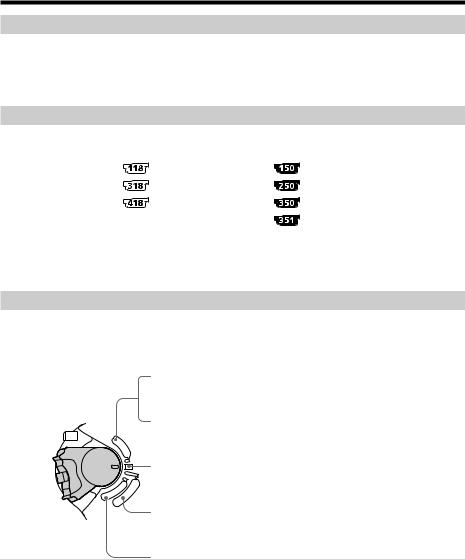
Using this manual
Note on connecting other equipment 



When you connect your camcorder to other video equipment or a computer using the USB cable or i.LINK cable, observe the shape of the jack.
If you forcibly insert the plug, the jack may be damaged and they may result in a malfunction of your camcorder.
On the model name indication
In this manual, camcorder-shape icons are used to indicate model names.
CCD-TRV118 : |
DCR-TRV150 : |
CCD-TRV318 : |
DCR-TRV250 : |
CCD-TRV418 : |
DCR-TRV350 : |
|
DCR-TRV351 : |
Instructions with no icons are for all models. Instructions with icons are for the indicated models only.
Before you start reading this manual, check the model name of your camcorder.
On the POWER switch
Modes on the POWER switch vary depending on models.
Consider this when following the operating instructions.
|
|
V |
O |
||
|
|
F |
|||
|
|
C F |
|||
|
|
R |
|
( |
|
|
|
|
|
|
C |
|
|
|
|
|
H |
POWER |
|
|
|
|
G |
|
|
|
|
) |
|
|
|
M |
M |
A |
C |
|
|
E |
M |
|
|
Y |
O |
|
|
||
|
|
E |
|
|
|
R |
R |
|
|
||
|
|
A |
|
|
|
VCR : 



e.g. Set the POWER switch to VCR.
or
PLAYER : 


e.g. Set the POWER switch to PLAYER.
OFF (CHG) : Common to all models
e.g. Set the POWER switch to OFF (CHG).
CAMERA : Common to all models
e.g. Set the POWER switch to CAMERA.
MEMORY : 

e.g. Set the POWER switch to MEMORY.
16
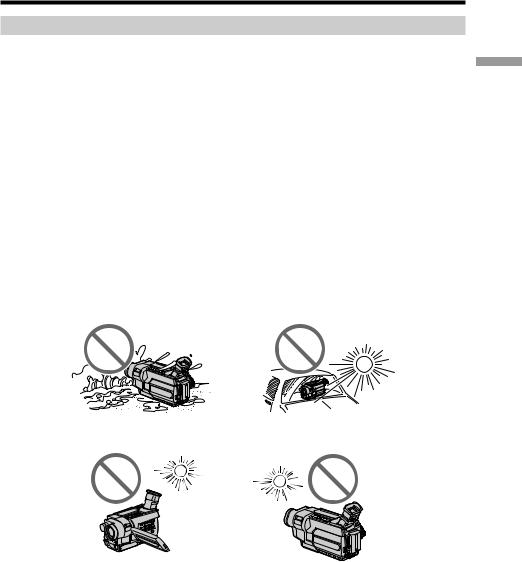
Using this manual
Precautions on camcorder care
Lens and LCD screen/finder
•The LCD screen and the finder are manufactured using extremely high-precision technology so over 99.99% of the pixels are operational for effective use. However, there may be some tiny black points and/or bright points (white, red, blue or green in color) that constantly appear on the LCD screen and the finder. These points are normal in the manufacturing process and do not affect the recording in any way.
•Do not let your camcorder become wet. Keep your camcorder away from rain and sea water. Letting your camcorder become wet may cause your camcorder to malfunction. Sometimes this malfunction cannot be repaired [a].
•Never leave your camcorder exposed to temperatures above 60°C (140°F), such as in a car parked in the sun or under direct sunlight [b].
•Be careful when placing the camera near a window or outdoors. Exposing the LCD screen, the finder or the lens to direct sunlight for long periods may cause malfunctions [c].
•Do not directly shoot the sun. Doing so might cause your camcorder to malfunction. Take pictures of the sun in low light conditions such as dusk [d].
Started Getting
[a] |
[b] |
[c] |
[d] |
17

Step 1 Preparing the power supply
Installing the battery pack
(1) Lift up the viewfinder.
(2) Slide the battery pack down until it clicks.






 1
1
2
To remove the battery pack
(1) Lift up the viewfinder.
(2) Slide the battery pack out in the direction of the arrow while pressing the BATT (battery) release lever down.
BATT (battery) release lever
If you install the large-capacity battery pack
If you install the NP-FM70/QM71/QM71D/FM90/FM91/QM91/QM91D battery pack on your camcorder, extend the viewfinder.
18
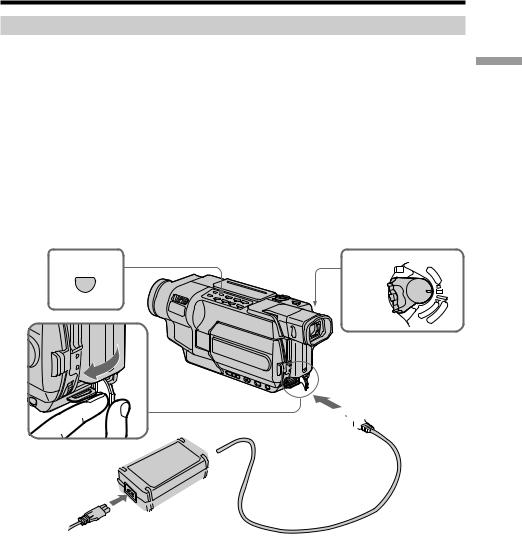
Step 1 Preparing the power supply
Charging the battery pack
Use the battery pack after charging it for your camcorder.
Your camcorder operates only with the “InfoLITHIUM” battery pack (M series). See page 242 for details of “InfoLITHIUM” battery pack.
(1) Open the DC IN jack cover and connect the AC Adaptor supplied with your camcorder to the DC IN jack with the plug’s vmark facing up.
(2) Connect the power cord to the AC Adaptor. (3) Connect the power cord to a wall outlet. (4) Set the POWER switch to OFF (CHG).
The charge lamp lights up when charging begins.
Started Getting
BATT INFO |
4 |
|
|
V |
|
O |
|||
|
|
|
C |
|
F |
||
|
|
|
R |
F |
|||
|
|
|
|
|
|
|
( |
|
|
|
|
|
|
|
C |
POWER |
|
|
|
|
|
|
H |
|
|
|
|
|
|
G |
|
|
|
|
|
|
|
|
) |
|
|
|
E |
M |
|
A |
C |
R |
M |
|
M |
|
|||
Y |
O |
|
E |
|
|
||
|
|
|
R |
|
|
|
|
|
|
A |
|
|
|
|
|

 1
1
2 

19
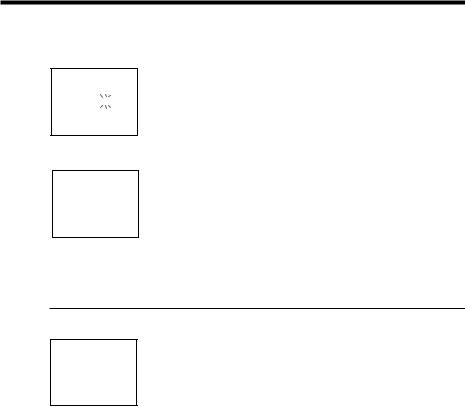
Step 1 Preparing the power supply
To check the state of the battery (BATTERY INFO)
Open the LCD panel while pressing OPEN, then press BATT INFO. The BATTERY INFO is displayed for about seven seconds.
|
|
BATTERY INFO |
|
|
|||||
BATTERY |
CHARGE |
LEVEL |
|||||||
0% |
|
|
|
50% |
|
|
100% |
||
|
|
|
|
|
|
|
|
|
|
REC TIME AVAILABLE LCD SCREEN: 56 min VIEWFINDER: 73 min
The battery charge level is displayed as percentage and recordable time with the LCD screen/viewfinder.
The battery charge level is displayed in 10% increments.
Charging
j
|
|
BATTERY INFO |
|
|
|||||
BATTERY |
CHARGE |
LEVEL |
|||||||
0% |
|
|
|
50% |
|
|
100% |
||
|
|
|
|
|
|
|
|
|
|
REC TIME AVAILABLE LCD SCREEN: 80 min VIEWFINDER: 105 min
Full charge
When the battery is fully charged, the battery charge level indicator shows 100% and the charge lamp goes out.
After charging the battery pack
Disconnect the AC Adaptor from the DC IN jack on your camcorder.
Until the remaining battery charge is calculated
|
|
BATTERY INFO |
|
|
|||||
BATTERY |
CHARGE |
LEVEL |
|||||||
0% |
|
|
|
50% |
|
|
100% |
||
|
|
|
|
|
|
|
|
|
|
CALCULATING
BATTERY INFO...
The battery charge level indicator moves flashing and “CALCULATING BATTERY INFO...” is displayed.
Note
Prevent metallic objects from coming into contact with the metal parts on the DC plug of the AC Adaptor. This may cause a short-circuit, damaging the AC Adaptor.
When you use the AC Adaptor
Place the AC Adaptor near a wall outlet. If any trouble occurs with this unit, disconnect the plug from the wall outlet as soon as possible to cut off the power.
The numeric value displayed in the BATTERY INFO
Refer to the value displayed in the BATTERY INFO as a rough standard.
To display the BATTERY INFO longer
Press BATT INFO again while the BATTERY INFO is still displayed. The information is displayed for another seven seconds.
If you keep pressing BATT INFO, the BATTERY INFO is displayed for up to about 20 seconds.
The BATTERY INFO is not displayed in the following cases:
–The POWER switch is not set to OFF (CHG).
–The battery pack is not installed properly.
–The battery pack is fully discharged.
20

Step 1 Preparing the power supply
If the power goes off although the remaining battery time indicator indicates that the battery pack has enough power to operate
Charge the battery pack fully again so that the indication is correct.
What is “InfoLITHIUM”?
The “InfoLITHIUM” is a lithium ion battery pack that can exchange data such as battery consumption with compatible electronic equipment. This unit is compatible with the “InfoLITHIUM” battery pack (M series). Your camcorder operates only with the “InfoLITHIUM” battery. “InfoLITHIUM” M series battery packs have the
mark (p. 242).
TM
SERIES
Charging time
Battery pack |
Full charge |
NP-FM30 (supplied) |
145 |
NP-FM50 |
150 |
NP-FM70 |
240 |
NP-QM71/QM71D |
260 |
NP-FM90 |
330 |
|
|
NP-FM91/QM91/QM91D |
360 |
|
|
Approximate minutes to charge an empty battery pack at 25°C (77°F).
The charging time may increase if the battery’s temperature is extremely high or low because of the ambient temperature.
Started Getting
21
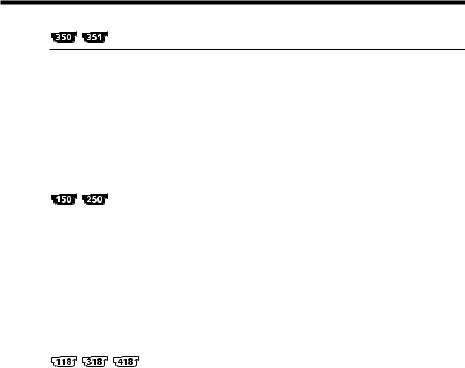
Step 1 Preparing the power supply
Recording time
|
|
Recording with |
Recording with |
||
Battery pack |
the viewfinder |
the LCD screen |
|||
|
|
Continuous |
Typical* |
Continuous |
Typical* |
NP-FM30 (supplied) |
105 |
50 |
80 |
40 |
|
NP-FM50 |
170 |
85 |
130 |
70 |
|
NP-FM70 |
355 |
175 |
270 |
145 |
|
NP-QM71/QM71D |
415 |
205 |
315 |
165 |
|
NP-FM90 |
540 |
270 |
410 |
215 |
|
NP-FM91/QM91/QM91D |
625 |
310 |
475 |
250 |
|
|
|
|
|
||
|
|
Recording with |
Recording with |
||
Battery pack |
the viewfinder |
the LCD screen |
|||
|
|
Continuous |
Typical* |
Continuous |
Typical* |
NP-FM30 (supplied) |
115 |
55 |
85 |
40 |
|
NP-FM50 |
185 |
90 |
140 |
70 |
|
NP-FM70 |
385 |
190 |
295 |
145 |
|
NP-QM71/QM71D |
445 |
220 |
340 |
165 |
|
NP-FM90 |
580 |
285 |
450 |
220 |
|
NP-FM91/QM91/QM91D |
670 |
330 |
520 |
255 |
|
|
|
|
|
||
|
|
Recording with |
Recording with |
||
Battery pack |
the viewfinder |
the LCD screen |
|||
|
|
Continuous |
Typical* |
Continuous |
Typical* |
NP-FM30 (supplied) |
165 |
80 |
120 |
60 |
|
NP-FM50 |
265 |
130 |
195 |
100 |
|
NP-FM70 |
540 |
265 |
400 |
205 |
|
NP-QM71/QM71D |
640 |
315 |
465 |
235 |
|
NP-FM90 |
820 |
400 |
600 |
305 |
|
NP-FM91/QM91/QM91D |
955 |
465 |
695 |
355 |
|
Approximate minutes when you use a fully charged battery
*Approximate recording time.
The actual battery life may be shorter in the following cases:
–When you repeat recording start/stop, zooming and turning the power on/off.
–When the battery is used repeatedly or self-discharged after charging (p. 242).
22
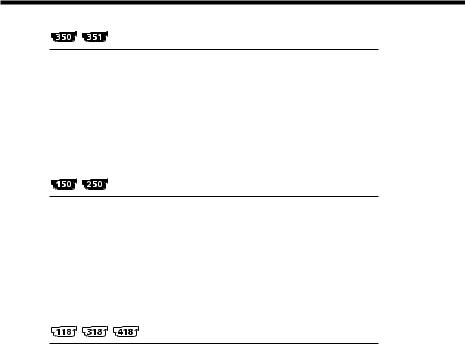
Step 1 Preparing the power supply
Playing time
Battery pack |
Playing on |
Playing with |
|
||
|
|||||
the LCD screen |
the LCD closed |
Getting |
|||
|
|||||
NP-FM50 |
135 |
195 |
|
||
NP-FM30 (supplied) |
80 |
120 |
|
|
|
|
|
|
|
Started |
|
NP-FM70 |
285 |
400 |
|
||
|
|
||||
NP-QM71/QM71D |
335 |
465 |
|
|
|
NP-FM90 |
435 |
600 |
|
|
|
NP-FM91/QM91/QM91D |
505 |
695 |
|
|
|
Battery pack |
Playing on |
Playing with |
|
the LCD screen |
the LCD closed |
||
|
|||
NP-FM30 (supplied) |
90 |
130 |
|
NP-FM50 |
150 |
210 |
|
NP-FM70 |
310 |
430 |
|
NP-QM71/QM71D |
365 |
505 |
|
NP-FM90 |
475 |
655 |
|
NP-FM91/QM91/QM91D |
550 |
755 |
Battery pack |
Playing on |
Playing with |
|
the LCD screen |
the LCD closed |
||
|
|||
|
|
|
|
NP-FM30 (supplied) |
120 |
175 |
|
NP-FM50 |
195 |
280 |
|
NP-FM70 |
400 |
570 |
|
NP-QM71/QM71D |
465 |
675 |
|
NP-FM90 |
600 |
865 |
|
NP-FM91/QM91/QM91D |
695 |
1010 |
Approximate minutes when you use a fully charged battery
23
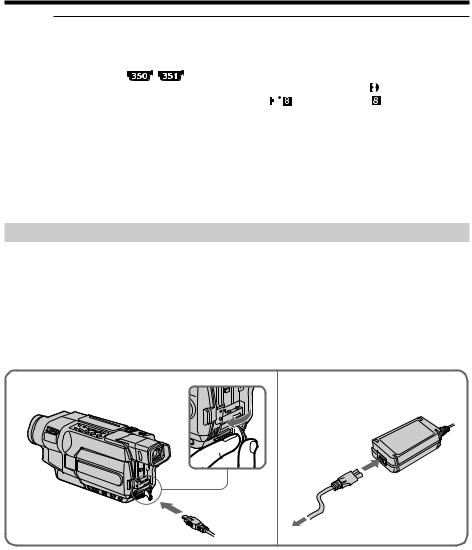
Step 1 Preparing the power supply
Note
Approximate continuous playing time at 25°C (77°F). The battery life will be shorter if you use your camcorder in a cold environment.
Playback time |
|
|
|
The table shows the playing time for tapes recorded in the Digital8 |
system. |
||
The playing time of tapes recorded in the Hi8 |
|
/standard 8 mm |
system is reduced |
|
|||
by about 20%. |
|
|
|
You can charge the battery in other countries
For details, see page 246.
Recommended charging temperature
We recommend charging the battery pack in an ambient temperature of between 10°C to 30°C (50°F to 86°F).
Connecting to a wall outlet
When you use your camcorder for a long time, we recommend that you power it from a wall outlet using the AC Adaptor.
(1) Open the DC IN jack cover, and connect the AC Adaptor to the DC IN jack on your camcorder with the plug’s vmark facing up.
(2) Connect the power cord to the AC Adaptor. (3) Connect the power cord to a wall outlet.
1 |
2, 3 |
24

Step 1 Preparing the power supply
PRECAUTION
The set is not disconnected from the AC power source (house current) as long as it is connected to the wall outlet, even if the set itself has been turned off.
Notes
•The AC Adaptor can supply power even if the battery pack is attached to your camcorder.
•The DC IN jack has “source priority.” This means that the battery pack cannot supply any power if the power cord is connected to the DC IN jack, even when the power cord is not plugged into a wall outlet.
•Place the AC Adaptor near a wall outlet.
While using the AC Adaptor, if any trouble occurs with this unit, disconnect the plug from the wall outlet as soon as possible to cut off the power.
Using a car battery
Use Sony Car Battery Adaptor (optional). Refer to the operating instructions of the Car Battery Adaptor for further information.
Started Getting
25
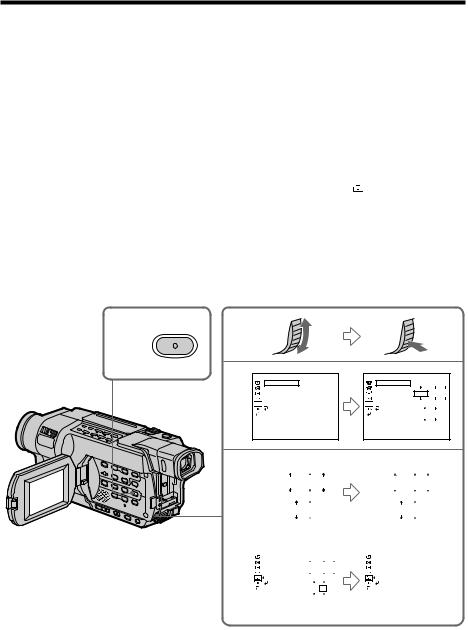
Step 2 Setting the date and time
Set the date and time when you use your camcorder for the first time. “CLOCK SET” will be displayed each time when you set the POWER switch to CAMERA or MEMORY unless you set the date and time settings.*
If you do not use your camcorder for about three months, the date and time settings may be cleared from memory (bars may appear) because the built-in rechargeable battery will have been discharged (p. 249).
Set the date and time after charging the built-in battery fully.
Set the year, then the month, the day, the hour and then the minute.
(1) Set the POWER switch to CAMERA or MEMORY, and then press MENU to display the menu settings.*
(2) Turn the SEL/PUSH EXEC dial to select CLOCK SET in  , then press the dial.
, then press the dial.
(3) Turn the SEL/PUSH EXEC dial to select the desired year, then press the dial. (4) Set the month, day and hour by turning the SEL/PUSH EXEC dial and
pressing the dial.
(5) Set the minute by turning the SEL/PUSH EXEC dial and pressing the dial by the time signal. The clock starts.
(6) Press MENU to make the menu settings disappear.
1,6
MENU
2
SETUP MENU
CLOCK SET – –:– –:– –
USB STREAM
LTR SIZE
LANGUAGE
 DEMO MODE
DEMO MODE
RETURN
[MENU] : END
SETUP MENU |
|
CLOCK SET |
|
USB STREAM |
2003 JAN 1 |
LTR SIZE |
LANGUAGE

 DEMO MODE
DEMO MODE
RETURN
12 00 AM
[MENU] : END
3 |
|
|
|
|
1 |
|
|
2003 |
|
|
|
1 |
|
|
||
|
|
|
2003 |
JAN |
|
JAN |
|
|
|
|||||||
|
12 |
00 AM |
|
12 |
00 AM |
|
|
|||||||||
|
|
|
|
|
|
|
|
|
|
|
|
|
|
|
|
|
|
|
|
|
|
|
|
|
|
|
|
|
|
|
|
|
|
5 |
|
|
|
|
|
|
|
|
|
|
|
|
|
|
|
|
SETUP MENU |
|
|
|
|
|
SETUP MENU |
|
|
|
|||||||
|
CLOCK SET |
|
|
|
|
|
|
CLOCK SET |
|
JUL |
4 2003 |
|
||||
|
USB STREAM |
2003 |
JUL 4 |
|
|
|
USB STREAM |
5:30:00 PM |
|
|||||||
|
|
LTR SIZE |
|
|
|
LTR SIZE |
|
|
|
|
|
|
||||
|
|
LANGUAGE |
|
|
|
|
|
|
LANGUAGE |
|
|
|
|
|
|
|
|
|
DEMO MODE |
|
|
|
|
|
|
DEMO MODE |
|
|
|
||||
|
|
RETURN |
5 |
30 PM |
|
|
|
RETURN |
|
|
|
|
|
|
||
|
|
|
|
|
|
|
|
|
|
|
|
|
|
|||
|
|
[MENU] : END |
|
|
|
|
|
[MENU] : END |
|
|
|
|||||
|
|
|
|
|
|
|
|
|
|
|
|
|
|
|
|
|
* Modes on the POWER switch vary depending on models (p. 16).
26
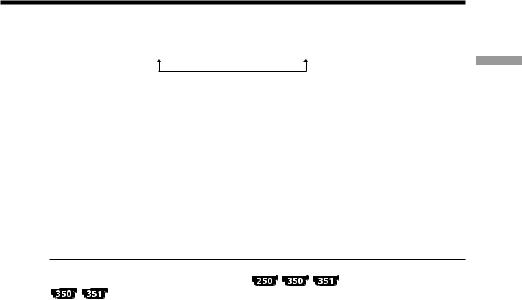
Step 2 Setting the date and time
The year changes as follows:
2000 


 2003
2003 


 2079
2079
To check the preset date and time 


Press DATE to display the date indicator. Press TIME to display the time indicator.
Press DATE (or TIME) and then press TIME (or DATE) to simultaneously display the date and time indicator.
Press DATE and/or TIME again. The date and/or time indicator disappears.
Auto date function 


When you use your camcorder for the first time, turn it on and set the date and time to your local time before you start recording (p. 26). The date is automatically recorded for 10 seconds after you start recording (Auto date function). This function works only once a day.
If you do not set the date and time |
|
“--- -- ----” “--:--:--” is recorded on the tape |
or the “Memory Stick” |
. |
|
Note on the time indicator
The internal clock of your camcorder operates on a 12-hour cycle.
•12:00 AM stands for midnight.
•12:00 PM stands for noon.
Note on the auto date function 


You can change the AUTO DATE setting by selecting ON or OFF in the menu settings. The auto date function automatically displays the date once a day.
However, the date may automatically appear more than once a day if:
–you set the date and time.
–you eject and insert the tape again.
–you stop recording within 10 seconds.
–you set AUTO DATE to OFF once and set it back to ON in the menu settings.
Started Getting
27

Step 3 Inserting a cassette
See page 15 for details about the usable cassettes types.
(1) Prepare the power source (p. 18).
(2) Slide OPEN/EJECT in the direction of the arrow and open the lid. The cassette compartment automatically lifts up and opens.
(3) Push the center of the cassette back and insert the cassette properly with the cassette window facing up.
(4) Close the cassette compartment by pressing  on the cassette compartment. The cassette compartment automatically goes down.
on the cassette compartment. The cassette compartment automatically goes down.
(5) After the cassette compartment goes down completely, close the lid until it clicks.
2 |
3,4 |
5 |
To eject the cassette
Follow the procedure above, and take out the cassette in step (3).
28
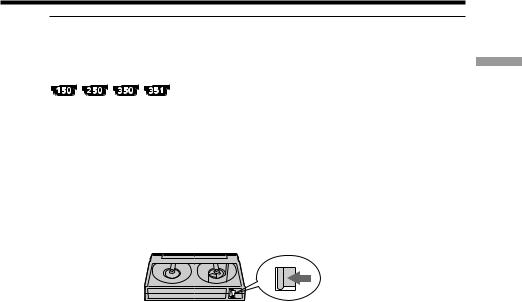
Step 3 Inserting a cassette
Notes
•Do not press the cassette compartment down. Doing so may cause a malfunction.
•The cassette compartment may not be closed when you press any part of the cassette
compartment other than the  mark.
mark.
•Your camcorder records pictures in the Digital8 system.
system.
•The recording time when you use your camcorder is half of the indicated time on Hi8


 tape. If you select the LP mode in the menu settings, the recording time is 3/4 of the indicated time on Hi8
tape. If you select the LP mode in the menu settings, the recording time is 3/4 of the indicated time on Hi8

 tape.
tape.
•If you use standard 8 mm tape, be sure to play back the tape on your camcorder. Mosaic noise may appear when you play back standard 8 mm
tape, be sure to play back the tape on your camcorder. Mosaic noise may appear when you play back standard 8 mm tape on other camcorders (including another DCR-TRV150/TRV250/TRV350/TRV351).
tape on other camcorders (including another DCR-TRV150/TRV250/TRV350/TRV351).
To prevent accidental erasure
Slide the write-protect tab on the cassette to expose the red mark.
Started Getting
29
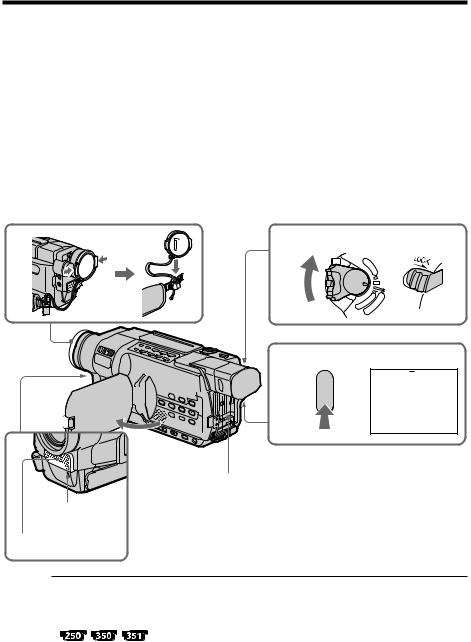
— Recording – Basics —
Recording a picture
Your camcorder automatically focuses.
(1) Remove the lens cap and attach the lens cap to the grip strap.
(2) Install the power source and insert a cassette. See “Step 1” to “Step 3” for more information (p. 18 to 29).
(3) Set the POWER switch to CAMERA while pressing the small green button. This sets your camcorder to the standby mode.
(4) Open the LCD panel while pressing OPEN. The viewfinder automatically turns off.
(5) Press START/STOP. Your camcorder starts recording. The REC indicator appears on the screen. The camera recording lamp located on the front of your camcorder lights up. To stop recording, press START/STOP again.
The recording lamp lights up in the viewfinder when you record with the viewfinder.
1 |
3 |
POWER
V |
O |
C |
F |
R |
|
|
F |
|
( |
|
C |
|
H |
|
G |
|
) |
|
E |
M |
R |
M |
M |
O |
E |
|
Y |
|
|
|
R |
|
|
A |
|
A
C
5
4 







2
 50min
50min  SP REC 0:00:01
SP REC 0:00:01
Camera recording lamp
Microphone
Notes
•The data code (date/time when recorded) are not displayed during recording. However, they are recorded automatically onto the tape. To display the data code (date/time), press DATA CODE on the Remote Commander during playback.
•Fasten the grip strap firmly.
•Do not touch the built-in microphone during recording.
30
